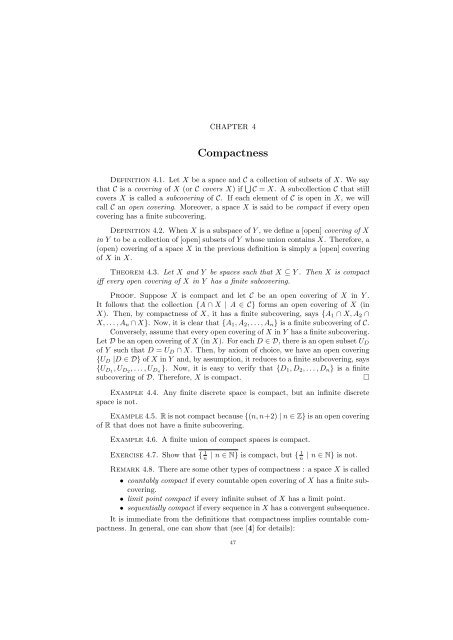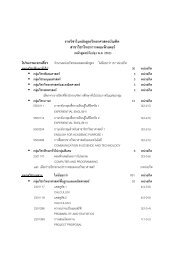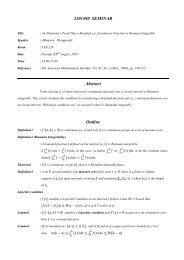Lecture Notes Topology (2301631) Phichet Chaoha Department of ...
Lecture Notes Topology (2301631) Phichet Chaoha Department of ...
Lecture Notes Topology (2301631) Phichet Chaoha Department of ...
You also want an ePaper? Increase the reach of your titles
YUMPU automatically turns print PDFs into web optimized ePapers that Google loves.
CHAPTER 4<br />
Compactness<br />
Definition 4.1. Let X be a space and C a collection <strong>of</strong> subsets <strong>of</strong> X. We say<br />
that C is a covering <strong>of</strong> X (or C covers X) if ∪ C = X. A subcollection C that still<br />
covers X is called a subcovering <strong>of</strong> C. If each element <strong>of</strong> C is open in X, we will<br />
call C an open covering. Moreover, a space X is said to be compact if every open<br />
covering has a finite subcovering.<br />
Definition 4.2. When X is a subspace <strong>of</strong> Y , we define a [open] covering <strong>of</strong> X<br />
in Y to be a collection <strong>of</strong> [open] subsets <strong>of</strong> Y whose union contains X. Therefore, a<br />
(open) covering <strong>of</strong> a space X in the previous definition is simply a [open] covering<br />
<strong>of</strong> X in X.<br />
Theorem 4.3. Let X and Y be spaces such that X ⊆ Y . Then X is compact<br />
iff every open covering <strong>of</strong> X in Y has a finite subcovering.<br />
Pro<strong>of</strong>. Suppose X is compact and let C be an open covering <strong>of</strong> X in Y .<br />
It follows that the collection {A ∩ X | A ∈ C} forms an open covering <strong>of</strong> X (in<br />
X). Then, by compactness <strong>of</strong> X, it has a finite subcovering, says {A 1 ∩ X, A 2 ∩<br />
X, . . . , A n ∩ X}. Now, it is clear that {A 1 , A 2 , . . . , A n } is a finite subcovering <strong>of</strong> C.<br />
Conversely, assume that every open covering <strong>of</strong> X in Y has a finite subcovering.<br />
Let D be an open covering <strong>of</strong> X (in X). For each D ∈ D, there is an open subset U D<br />
<strong>of</strong> Y such that D = U D ∩ X. Then, by axiom <strong>of</strong> choice, we have an open covering<br />
{U D |D ∈ D} <strong>of</strong> X in Y and, by assumption, it reduces to a finite subcovering, says<br />
{U D1 , U D2 , . . . , U Dn }. Now, it is easy to verify that {D 1 , D 2 , . . . , D n } is a finite<br />
subcovering <strong>of</strong> D. Therefore, X is compact.<br />
□<br />
Example 4.4. Any finite discrete space is compact, but an infinite discrete<br />
space is not.<br />
Example 4.5. R is not compact because {(n, n+2) | n ∈ Z} is an open covering<br />
<strong>of</strong> R that does not have a finite subcovering.<br />
Example 4.6. A finite union <strong>of</strong> compact spaces is compact.<br />
Exercise 4.7. Show that { 1 n | n ∈ N} is compact, but { 1 n<br />
| n ∈ N} is not.<br />
Remark 4.8. There are some other types <strong>of</strong> compactness : a space X is called<br />
• countably compact if every countable open covering <strong>of</strong> X has a finite subcovering.<br />
• limit point compact if every infinite subset <strong>of</strong> X has a limit point.<br />
• sequentially compact if every sequence in X has a convergent subsequence.<br />
It is immediate from the definitions that compactness implies countable compactness.<br />
In general, one can show that (see [4] for details):<br />
47





